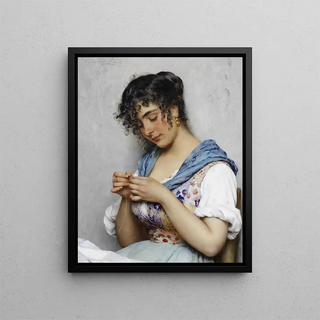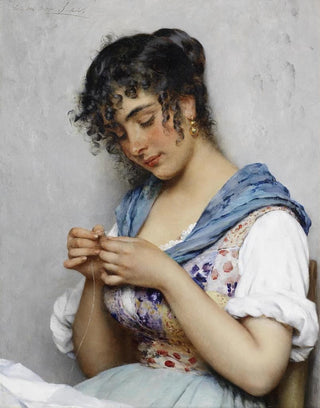Art print | The Italian seamstress - Eugen von Blaas


View from behind

Frame (optional)
In the fascinating world of art, some works transcend the simple frame to become witnesses of an era, reflections of a culture. "The Italian seamstress" by Eugen von Blaas is one of those creations that, through its depth and delicacy, invites a sensory journey into the heart of 19th-century daily life. The piece depicts an intimate scene where the protagonist, dressed in an elegant dress, seems to capture the moment in an atmosphere of concentration and creativity. The soft light bathing the scene highlights the refined details and rich textures, making each brushstroke almost tangible. This art print thus offers an immersion into Blaas's artistic universe, while reminding us of the importance of craftsmanship and manual work in the society of his time.
Style and uniqueness of the work
Eugen von Blaas's style is often characterized by meticulous attention to detail and a vibrant color palette. In "The Italian seamstress," every element, from fabric to accessories, is treated with precision that reflects a deep respect for the subject. The artist excels in depicting textures, bringing fabrics to life under the seamstress's fingers. The composition of the piece, both simple and evocative, allows the viewer to immerse themselves in the intimacy of the workspace. The nuances of light and shadow create a warm, almost palpable atmosphere, while the seamstress's focused and serene gaze draws the eye and invites contemplation. This work is not just a visual representation; it also evokes emotions and memories, reminding everyone of the importance of everyday gestures.
The artist and his influence
Eugen von Blaas, born in 1843 in Venice, is a prominent representative of the academic movement and a master of genre painting. His artistic training led him to explore various subjects, but it is often daily life and women of his time that inspire him the most. The influence of Italian culture is omnipresent in his work, and "The Italian seamstress" is a perfect example. Blaas has managed to capture not only

Matte finish

View from behind

Frame (optional)
In the fascinating world of art, some works transcend the simple frame to become witnesses of an era, reflections of a culture. "The Italian seamstress" by Eugen von Blaas is one of those creations that, through its depth and delicacy, invites a sensory journey into the heart of 19th-century daily life. The piece depicts an intimate scene where the protagonist, dressed in an elegant dress, seems to capture the moment in an atmosphere of concentration and creativity. The soft light bathing the scene highlights the refined details and rich textures, making each brushstroke almost tangible. This art print thus offers an immersion into Blaas's artistic universe, while reminding us of the importance of craftsmanship and manual work in the society of his time.
Style and uniqueness of the work
Eugen von Blaas's style is often characterized by meticulous attention to detail and a vibrant color palette. In "The Italian seamstress," every element, from fabric to accessories, is treated with precision that reflects a deep respect for the subject. The artist excels in depicting textures, bringing fabrics to life under the seamstress's fingers. The composition of the piece, both simple and evocative, allows the viewer to immerse themselves in the intimacy of the workspace. The nuances of light and shadow create a warm, almost palpable atmosphere, while the seamstress's focused and serene gaze draws the eye and invites contemplation. This work is not just a visual representation; it also evokes emotions and memories, reminding everyone of the importance of everyday gestures.
The artist and his influence
Eugen von Blaas, born in 1843 in Venice, is a prominent representative of the academic movement and a master of genre painting. His artistic training led him to explore various subjects, but it is often daily life and women of his time that inspire him the most. The influence of Italian culture is omnipresent in his work, and "The Italian seamstress" is a perfect example. Blaas has managed to capture not only






